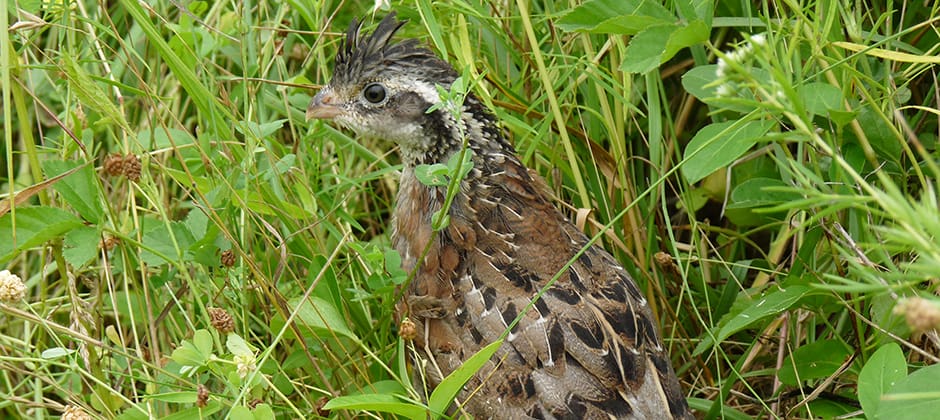Share this article
Battling to help bobwhite endure climate change
Even at Manassas National Battlefield Park, it’s hard to get a glimpse of a bobwhite, although its namesake call can be heard throughout the grasslands. For decades, the northern Virginia park has fostered a resident bobwhite (Colinus virginianus) population, and it manages its grasslands to benefit the elusive bird. The battlefield provides the early successional habitat—a mix of native grasses, legumes, forbs, shrubs and low woody cover—that the bobwhite favors. Plus, it offers plenty of insects for nesting hens and chicks to eat, open areas for brood-rearing and a mix of native shrubs, vines and young trees for cover.
Climate change could drastically alter this landscape, though. Urban sprawl has already reduced and fragmented the piedmont prairie grasslands the birds occupy. As bobwhite tend to have very specialized requirements, concern is mounting over their ability to survive climate change, forcing managers to adapt their practices over the next decade to respond to shifting conditions.
This article is a version of the final project I wrote for the Climate Academy, a program hosted by the Department of the Interior’s U.S. Fish and Wildlife Service that teaches natural resource professionals about the fundamentals of climate science and how to incorporate climate adaptation into everyday management. The program changed my perspective and forced me to consider long-term planning through a lens I had never viewed it through before.
Virginia lacks the shrinking glaciers and disappearing snowpack that serve as glaring signs of climate change elsewhere. I assumed its climate features would stay about the same as they always were. That’s not likely, though. I realized that as a park biologist, I could best serve Manassas—including its popular bobwhites—by being an adaptable thinker and a long-term planner.
Manassas Battlefield Park is an active member of the National Bobwhite Conservation Initiative, which hosts a program seeking to demonstrate conclusively that, with landscape-scale habitat management, the declining bird species can recover. Each year, biologists and land managers conduct spring presence/absence surveys, summer habitat evaluations and fall covey surveys, which help inform the next year’s management.
The park’s top priority has been providing habitat. A rotational prescribed burn program reduces overgrowth and opens bare ground for brood cover. Seeding efforts foster beneficial forbs and legumes. Shrub and tree planting provides food and attracts insects that also become food.
These efforts may be undone by climate change, however. The Hot House Earth theory teaches us to anticipate extreme weather events—like seasonal droughts and heavier rainstorms—and warmer, earlier springs. While Manassas’s mature grasslands face little risk of erosion from intense rains, drought could dry out grasses, affecting managers’ ability to safely conduct controlled burns at the right time of year.
Climate change may also exacerbate the spread of invasive plants, which often leaf out before native species. Warmer, earlier springs could help them outcompete native species, completely changing the ecology of a site. Managers will need to continually put invasive plant management at the forefront of any habitat management plan.
Changes in weather and temperatures can also shift wildlife ranges, forcing wildlife to either adapt to new locations or die out. Bobwhite in Manassas could likely adapt, but if populations are unable to make the shift, local extinction is possible. To plan for their adaptation, managers need to define site objectives, assess climate impacts, evaluate objectives, identify adaptive approaches and monitor how effective the plan has been.
My main concern at Manassas is a mismatch developing between bobwhite and the park’s plant and insect communities. A phenological mismatch occurs when two or more species that interact with one another experience a change in the timing of their life cycles at different rates. With Manassas bobwhite, such a mismatch is likely to occur in the future. Bloom dates for native plants are susceptible to change over the next decade or two. Many native, warm-season grasses and plants that support bobwhite bloom at the end of the summer and into fall.
Change is likely to go one of two ways. Either an earlier spring promotes earlier bloom and seed set, or longer, warmer seasons promote later bloom and seed set. Either way, bobwhite won’t be able to rely on the same seeds being present at the same time of year. The changing ecosystem may not even support some native plants.
By building a database of native plants’ bloom dates, seed production times, and other phenological data, managers could make sure forage is always available for bobwhite. By removing invasive species, they could ensure that most of the habitat consisted of beneficial plants—no matter what the changing climate brings.
The Climate Academy is offered through the U.S. Fish and Wildlife Service National Conservation Training Center (NCTC) and is developed each year through the work of partner organizations — USFWS’ NCTC, The Wildlife Society, Association of Fish and Wildlife Agencies, National Park Service, California Department of Fish and Wildlife, Northeast Climate Adaptation Science Center and America Adapts Climate Change podcast. The goal of the program is to cover the fundamentals of climate science, provide tools and resources for climate adaptation and increase climate literacy and communication. The Wildlife Society serves on the Climate Academy Coordination Team.
Header Image: Manassas National Battlefield Park manages its grasslands for bobwhite. Courtesy of Bryan Gorsira








